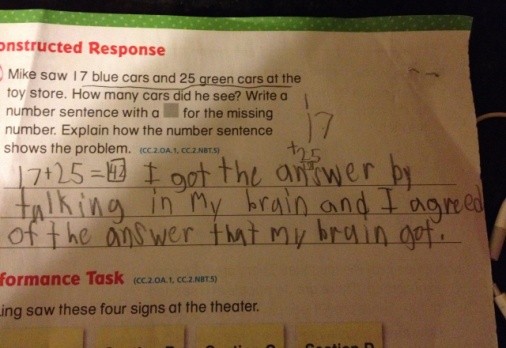Day 106
For one year, 365 days, this blog will address the Common Core Standards from the perspective of creating an alternate, ambient learning environment for math. Ambient is defined as “existing or present on all sides, an all-encompassing atmosphere.” And ambient music is defined as: “Quiet and relaxing with melodies that repeat many times.”
Why ambient? A math teaching style that’s whole and all encompassing, with themes that repeat many times through the years, is most likely to be effective and successful. Today’s standard will be listed in blue, followed by its ambient counterpart.
Number and Operations in Base Ten 1.NBT
Use place value understanding and properties of operations to add and subtract.
4. Add within 100, including adding a two-digit number and a one-digit number, and adding a two-digit number and a multiple of ten, using concrete models or drawings and strategies based on place value, properties of operations, and/or the relationship between addition and subtraction; relate the strategy to a written method and explain the reasoning used. Understand that in adding two-digit numbers, one adds tens and tens, ones and ones, and sometimes it is necessary to compose a ten.
Ah, the Common Core. Again, unfamiliar territory tends to be introduced with interpretive lessons and homework that seem unnecessarily unwieldy and complex. I’m afraid that the concrete models or drawings and strategies have taken the form of the polka dots and hash marks that have puzzled parents and children alike and appeared so frequently online and in the media. The rushed implementation that’s resulted in inadequate orientation for teachers may be responsible for some of the confusion. But complicating a simple 2-step equation with a mega multi-step solution that includes complex visuals is questionable at best.
“Explaining the reasoning used” is really beyond the innate logical ability of a 6-7 year old. Or, considering Piaget’s theory of child development recommending concrete vs abstract thinking from ages 7-12, any child under 12 for that matter. The now famous example of a second grader’s “constructed response” illustrates the fact that the capacity to reason abstractly has not yet dawned. See the actual second grade Q&A below.
Place value per se is not brought in the Waldorf or Math By Hand method until Grade 2, when it’s taught with large, colorful manipulatives. Four color-coded columns are placed on the floor with large numbers for the 1’s, 10’s, 100’s, and 1,000’s place values, and small numbers that are physically jumped all the way to the tops of the columns. This will be explored in depth in the Grade 2 posts. For now in Grade 1, the 4 processes continue to be practiced side-by side, so that the relationship, not only of addition to subtraction, but of all 4 to each other, is continually experienced. Equations are kept in a horizontal format until the end of Grade 1 or the beginning of Grade 2, when they are switched to a vertical format.
As always, it’s the movement, story, and art that win the day with math! Knowledge ensues in an environment dedicated to imaginative, creative knowing, where student and teacher alike surrender to the ensuing of that knowledge as a worthy goal. More Common Core Grade 1 Number and Operations in Base Ten Standards with their ambient counterparts tomorrow!













